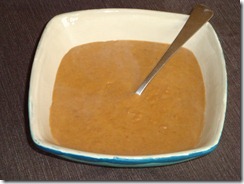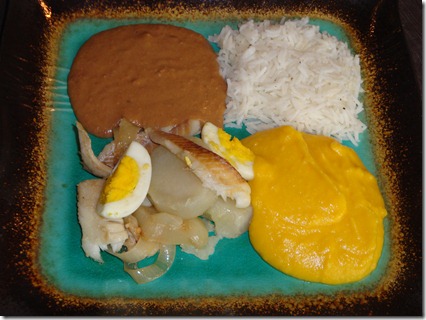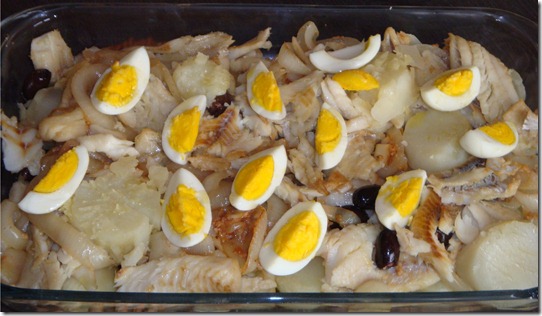Source: Modified from the series “Cozinha Regional Brasileira” (Brazilian Regional Cuisine, http://www.cozinharegional.com.br), books 5 (Rio de Janeiro) and 6 (Pernambuco)
History: The typical Easter food in most of Brazil is the “bacalhau” (salted cod). It actually originated from the Portuguese cuisine (the recipe I prepared today, listed in the book for the state of Rio de Janeiro, has its origins in Portugal and is considered one of its greatest bacalhau recipes). The side dishes are more “Brazilian” (I think, as I’ve talked from people from other parts of the Brazil who didn’t know them), and I’ve found them in the book for the state of Pernambuco.
The “Bacalhau à Gomes de Sá” is named for the Portuguese who created it in the 19th century. My great-grandparents were Portuguese, so I’ve had it many times while growing up, and it’s great for its simplicity – essentially a casserole of cod, potatoes and onions (with lots of olive oil).
The side dishes, “feijão de coco” (beans with coconut milk) and “quibebe” (pumpkin / onion purée with coconut milk) are typical from the Northeast of Brazil (I’ve talked to people from other parts of the country who didn’t know them). The former I remember since I was a kid, the latter I only knew later, but in my wife’s family it’s been a part of the traditional Easter lunch for a long time.
Variation from the original: The biggest one was that I didn’t find “real” bacalhau (salted cod), I could only find salted pollock. It didn’t taste exactly like the original, but it was close enough (the salting process gives its distinctive flavor). The fish was also in small, thin strips, which limited the number of recipes I could do with it (some recipes ask for a thicker cut of the fish), but it worked out fine for the “Gomes de Sá”. Someday I’ll try to buy fresh cod (which is quite cheap around here) and leave it in salt for a few days to see if I get a better result. For the side dishes, I didn’t use an onion which the recipe asked for the beans (had used what I had for the other dishes), but it didn’t hurt the flavor too much, and I couldn’t find pumpkin at this time of the year for the “quibebe”, so I used a butternut squash instead.
Ingredients from specialty stores: The (fake) “bacalhau”, which I bought in a Brazilian store nearby. The coconut milk I can find in almost all supermarkets, in the Asian (Thai) food section.
Ingredients:
- Bacalhau:
- 1.5 lb “bacalhau”
- 6 medium potatoes, peeled, cooked “al dente”
- 2 medium onions, cut in rings
- 4 cloves garlic, minced
- black olives (I only had about 10, which is what I used, but I’d probably add at least 10 more if I had them)
- 4 hard-boiled eggs, quartered
- 4 tbsp. olive oil, plus some more for the casserole
- “Feijão de coco”
- 2 cups (cooked) beans (I had some leftover beans, which were already seasoned, so I could cut back on the salt and pepper)
- 1/2 cup coconut milk
- 1 tbsp. olive oil
- salt & pepper to taste
- “Quibebe”
- 1.5 lb butternut squash, peeled, seeded, cut in small cubes
- 1 medium onion, chopped in small cubes
- 1 cup coconut milk
- 1 tbsp. olive oil
- salt & pepper
- parsley for decoration
For all bacalhau recipes, the first step is to “unsalt” it, or remove the excess of salt. That can take up to a couple of days, depending on the thickness of the fish. First wash it under cold, running water to clean the salt which covers the fish. Then leave it in a bowl on the refrigerator with cold water and covered with plastic film, changing the water every ~4 hours. For thin strips (what I had), I changed the water 4 times, and it turned out great. After the salt was removed, you can also remove the water and cover it with milk (the fish will be more tender), but I skipped this step.
With the “unsalted” bacalhau, heat up 2 tbsp. olive oil in a large frying pan, then lightly fry the fish, until it starts becoming flaky, then remove and reserve. Cook the potatoes until they’re still a little firm, then cut in 1/2”-thick slices. Heat up 2 tbsp. oil on the same pan, then cook the onions until they soften. Add the olives and the garlic and cook about 5 more minutes, stirring often.
Add some oil to the bottom of a glass casserole, then add the potatoes, onions / garlic / olives and fish. Add the eggs on top and drizzle some more oil on top. About 15 minutes prior to serving, heat the oven to 350º and add the casserole inside for about 10 minutes.
For the “feijão de coco”: blend together 2 cups of (cooked) beans, 1 tbsp. olive oil and 1/2 cup of coconut milk. Put it on a medium pan and cook for about 15 minutes over medium heat, stirring constantly. Adjust the salt and pepper to taste.
For the “quibebe”: cook the squash and the onion covered with water until the squash is soft. Drain it and put in a blender, along with 1 cup of coconut milk. Blend them together, then move back to a pan, and cook it for about 15 minutes over medium heat, stirring often. Season to taste with salt and pepper.
Serve with white rice.
 |
 |
Enjoy!


I think you married me just to get my family’s quibebe recipe 🙂
That, and the palio 🙂